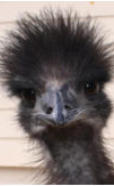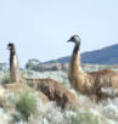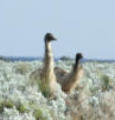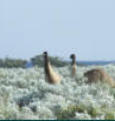

Emus



The word emu comes from the Portuguese
word 'ema', which means 'large bird'.
Standing up to 2 m tall, adult male emus are
Australia's largest birds. In size, they are
second only to ostriches in the world.
Their powerful legs give them great speed,
some running up to 50 km per hour. At full
pace, an emu's stride can measure up to 3
m.The emu belongs to a group of flightless
running birds with flat breastbones known as
ratites.
Ratites are the oldest of modern bird families.
They include kiwis, ostriches and cassowaries.
The emu's feathers are very primitive and
look like a form of coarse hair. The special
nature of these feathers enables emus to cope
with extreme changes in weather.
The emu's tracheal pouch, which is part of its
windpipe, is used for communication. It is
over 30 cm long and very thin-walled, and it
allows the bird to produce deep guttural
grunts. This pouch develops fully during the
breeding season and is most frequently used
during courtship.The emu is a hardy bird and
will survive in most parts of Australia's
rugged environment, but it avoids thickly
forested regions.
It thrives in remote places like the dry plains at Australia's
centre, the tropical woodlands to the north, and the cold
snowfields of the high country.Emus eat a wide variety of
leaves, grasses, fruits, native plants, and insects. In spring and
summer, their diet consists mainly of flowers and seeds. In
autumn, as those foods become scarce, they graze on young
grass which sprouts after summer rains. In winter, herbs form
the emu's main food.
They eat insects when these are available - such as during
grasshopper plagues.Emus eat a wide variety of leaves, grasses,
fruits, native plants, and insects. In spring and summer, their
diet consists mainly of flowers and seeds. In autumn, as those
foods become scarce, they graze on young grass which sprouts
after summer rains. In winter, herbs form the emu's main food.
They eat insects when these are available - such as during
grasshopper plagues.Emus do not have the option of flying
away if under attack from predators.
If attacked from above by other birds such as the wedge-tailed
eagle, emus will run in a zigzag pattern. However, at close
quarters their main defence is a swift kick or two with their
powerful legs.As courtship begins, the female emu's plumage
becomes slightly darker. When she finds a partner, the two of
them will build a nest of trampled grass in open or lightly-
covered country. A clutch of dark green eggs (usually between 5
and 20) is laid in May or June. The female then leaves the nest
area, after which she shows no more interest in her eggs or
partner.
She may simply wander off to join a group of non-breeding
birds, or she may find another mate and lay again.The male
incubates the eggs for eight to ten weeks. He seldom leaves the
eggs during this period, and can lose a considerable amount of
weight. He waits until they are all hatched before he and his
chicks leave the nest site.The young emus can remain with their
father for up to two years. Once fully grown, they may stay in
the same area or wander widely in search of food, water and a
mate. They become sexually mature at about 18 months of age
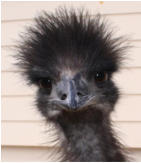
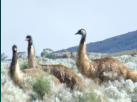
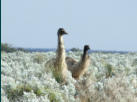
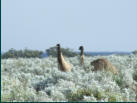


Emus


The word emu
comes from the
Portuguese word
'ema', which means
'large bird'.
Standing up to 2 m
tall, adult male
emus are Australia's
largest birds. In
size, they are second
only to ostriches in
the world.
Their powerful legs give them
great speed, some running up to 50
km per hour. At full pace, an emu's
stride can measure up to 3 m.The
emu belongs to a group of flightless
running birds with flat breastbones
known as ratites.
Ratites are the oldest of modern
bird families. They include kiwis,
ostriches and cassowaries. The
emu's feathers are very primitive
and look like a form of coarse hair.
The special nature of these
feathers enables emus to cope with
extreme changes in weather.
The emu's tracheal pouch, which is
part of its windpipe, is used for
communication. It is over 30 cm
long and very thin-walled, and it
allows the bird to produce deep
guttural grunts. This pouch
develops fully during the breeding
season and is most frequently used
during courtship.The emu is a
hardy bird and will survive in most
parts of Australia's rugged
environment, but it avoids thickly
forested regions.
It thrives in remote places like the
dry plains at Australia's centre, the
tropical woodlands to the north,
and the cold snowfields of the high
country.Emus eat a wide variety of
leaves, grasses, fruits, native
plants, and insects. In spring and
summer, their diet consists mainly
of flowers and seeds. In autumn,
as those foods become scarce, they
graze on young grass which
sprouts after summer rains. In
winter, herbs form the emu's main
food.
They eat insects when these are
available - such as during
grasshopper plagues.Emus eat a
wide variety of leaves, grasses,
fruits, native plants, and insects. In
spring and summer, their diet
consists mainly of flowers and
seeds. In autumn, as those foods
become scarce, they graze on
young grass which sprouts after
summer rains. In winter, herbs
form the emu's main food. They
eat insects when these are
available - such as during
grasshopper plagues.Emus do not
have the option of flying away if
under attack from predators.
If attacked from above by other
birds such as the wedge-tailed
eagle, emus will run in a zigzag
pattern. However, at close
quarters their main defence is a
swift kick or two with their
powerful legs.As courtship begins,
the female emu's plumage becomes
slightly darker. When she finds a
partner, the two of them will build
a nest of trampled grass in open or
lightly-covered country. A clutch of
dark green eggs (usually between 5
and 20) is laid in May or June. The
female then leaves the nest area,
after which she shows no more
interest in her eggs or partner.
She may simply wander off to join
a group of non-breeding birds, or
she may find another mate and lay
again.The male incubates the eggs
for eight to ten weeks. He seldom
leaves the eggs during this period,
and can lose a considerable
amount of weight. He waits until
they are all hatched before he and
his chicks leave the nest site.The
young emus can remain with their
father for up to two years. Once
fully grown, they may stay in the
same area or wander widely in
search of food, water and a mate.
They become sexually mature at
about 18 months of age
